C.M. Rosens's Blog, page 12
December 30, 2024
Exploring Gothic Horror Themes in Yelen & Yelena
YELEN & YELENA has several Gothic Horror elements. I’m going to provide some moderately spoiler-free examples below, then do a deep dive into some of the stronger horror themes/examples.
Sensuality, love and loss bound up together in an eerie, haunting settingAn isolated castle in the rot-infested forestUnnatural and uncanny situations (where the familiar becomes unfamiliar, e.g. discovering out-of-season foods at a Midsummer banquet in the middle of winter)A pragmatic heroine in distress trying to regain her agency and autonomy while navigating serious power imbalances (not in her favour)A brooding, burdened, male protagonist haunted by his brutish past, whose rotten castle’s appearance reflects his own fractured psycheDoubling Folk belief in spirits (that may or may not be the ghosts of the dead gods) alongside the mainstream religious beliefsInsidious, unstoppable, untameable forces working against the protagonistsDeath, suicide, murder, and a dark atmosphereCorruption and critique of officials, rulers and systemsI’ve probably missed a few, but that’s enough to be getting on with!
Now you can see how Yelen & Yelena is Gothic, let’s look in more detail at why it’s also horror:
Sporror & Body HorrorThere is a lot of body horror in Y&Y. It primarily relates to the rot, a magical fungal plague that emanates from the forest around the village. Once touched by the rot, it eats into your flesh and bones, so swift amputation is necessary. If spores are inhaled, there is no known cure. It infects soil, livestock, anything it touches.
A lot of this was influenced by the Foot and Mouth crisis in 2001. I can remember the images of burning livestock on TV, and local farms being under threat. At the start of Y&Y, the village is ringed by burning ditches to keep the rot back. Shepherds burn their whole flocks before retreating down the hillside. The whole atmosphere is one of a dying village, where everyone is leaving or has suffered some loss.
Those villagers still clinging on were like ticks on a dead dog, as Yelena’s father used to say. Yelena knew she was the same. She was embedded here too, stuck so deeply in her birthplace that it was taking accusations of dark sorcery to uproot her for a second time.
The rot affects everything it touches, but has fatal effects on both people and animals. It has become a repeating nightmare for the main secondary character, Velna, who her own POV.
Velna flailed, trying to regain her balance as a ragged shape swooped down from the branches above her, broken and oozing, gleaming eyes shining in the dark and bulging like mushroom caps.
She had a moment of numb clarity where she realised it was an owl, a rotted, crazed thing, spores floating around its wings, its fibrous pinions a mesh of wormy roots. Its tumescent little heart was partly exposed and pumping fit to burst as its body fell apart.
This is a small example of what is behind my comparison with T. Kingfisher’s What Moves the Dead, along with the decaying atmosphere of the Gothic castle, and the fantasy setting.
The Dead Gods & Religious HorrorI drew most of my inspiration for the ‘dead gods’ from The Epic of Gilgamesh. In that story, the gods destroy the world by a flood because they were sick of their creations’ prayers. I thought about having a very similar mythic history for the Decadian religion’s origin myths, but darker.
“Yes, one moment, it’s… let me translate, I’m a little rusty.” Yelen paused. “Very well. This talks about the dead gods. You know this story, yes? The dead gods accidentally created the Sacred Ten from the aftermath of their atrocities…”
Yelena didn’t like these stories. She liked the murals and carvings in the hostelry that celebrated the fall of the dead gods, but tales of their actual reign made her feel sick, their world too chaotic and dark to even imagine.
She tried to move him on. “How does the rot come in?”
“Wait, wait. I have it. Let me read it properly. Once, over the sun, past the moon, the gods fought a terrible battle, and from their dead oozed a terrible curse, the raw substance of all curses. It crept out from the realm of the gods and into the world when it was still new, and threatened everything. Page, please.”
Yelena turned the page, trying not to wince at the texture of it under her fingers. The book felt greasy; unclean.
The ‘dead gods’ are the previous pantheon, all slain in a cosmic battle (the first end of the world). They, like the gods in the Babylonian epic, hated the prayers of the mortals they had made. They sealed themselves off from their creation in a private realm. However, as they had made humankind from parts of themselves, they were bound to their creations by bonds of obligation and responsibility. They couldn’t shut the prayers out completely, only make it harder for the prayers to reach them.
Prayers could reach the gods only if a person acted as a conduit. They achieved this by reaching a state of total, blank-minded oblivion. In that moment of nothing, the prayers of others could be conducted through them, like a channel. The conduit-person could not pray themselves in this state, as any conscious thought on their part closed the channel.
At first, the gods were annoyed when people figured this out. They spitefully granted every prayer that came to them in this way, regardless of the consequences.
Inevitably, they started to find this amusing. They answered most prayers in odd, perverse ways, but they also granted ‘high-profile’ prayers as requested. This only encouraged more prayer requests for their entertainment.
As people realised you only had to pray to receive your heart’s desire, the demand for conduits increased. Temples of disciplined ascetics were in high demand. Some monks became catatonic and were eaten by sores because nobody would disturb them. Pleasure temples where the priestly duties included achieving this blank-minded state through orgasm also got disturbingly out of hand. Inflicting extreme pain or fear also effectively turned some sensitive souls into blank-minded conduits; consequently, warlords often embarked on “prayer raids” with professional torturers.
There were “prayer riots” where desperate people stormed temples to either access conduits for themselves, or to massacre them and prevent them falling into enemy hands/in retaliation for some atrocity the gods caused by answering prayer in a particularly perverse way.
After 10 separate near-apocalyptic atrocities caused by answered prayer, a new being was accidentally formed. Each one emerged from the lingering remnants of the gods’ power. This being was a child of the gods, in a sense, but was fully formed as an ageless adult. (Think Athena springing from Zeus).
The Sacred Ten / the Decad hated their creators, the gods, when they saw what the world had become. They also blamed the people themselves, and decided to wipe out humankind and start over. Each of the Sacred Ten picked a human to save, and these 10 survivors helped to shape the new world.
After destroying the living world, the Decad left it to the 10 survivors, went to fight the gods in their private realm, and slew them all. They then sealed up that realm with their own flesh. Each cut off a portion of themselves for the seal, but unfortunately, the Sacred Eighth had sustained so many wounds that —y couldn’t give enough of —-r flesh for their full share. A tiny crack remained. Through that crack, the ghosts of the dead gods escaped to haunt the living world as spirits, and their rotting corpses oozed out into the new world as the essence of all curses.
This myth is a prehistoric cosmological legend, but it features heavily as we learn more about what the rot is, where it comes from, and how to stop it.
In terms of timeline, this myth is the equivalent of being antediluvian, while Yelen & Yelena itself takes place in roughly the fantasy equivalent of the Industrial Revolution in Britain, perhaps early 1800s. So by now it’s a religious myth, and wild magic has been tamed (it’s now a power source, the equivalent of gas or electricity), and curses no longer really exist except in stories.
Or do they…?
NightmaresDreams come out of the Dream Gates. Burning a prayer bag of sweet herbs keeps the nightmare gate closed, so they say… but if you have terrible nightmares, they may or may not be your own bad memories.
Velna fell asleep in the strange bed, Yelena beside her, and dreamed the owl from the forest was outside the window.
The shutters were open, although the curtains were drawn across the glass. Its shape appeared behind the thin cloth – too thin for the winter, Velna thought, these curtains were meant for summer – like a severed head.
Velna got out of bed, gliding over to the window as if compelled. She didn’t want to pull the curtains back, because she knew what she would see.
In the dream, her hands were ghostly pale, as if she were already dead.
If I’m dead, what does it matter?
She nearly twitched the cloth aside, but a movement in her peripheral vision distracted her. The bed she had left was not a bed at all.
Yelena was lying on a stone table altar, carved like a bed, embedded with iron nails. She was bleeding, punctured, a priestess in ancient blood-soaked silks. She bucked and arched on her spiked altar, pleasuring herself with her legs open and hand skilfully engaged.
“This is for you,” Yelena said, turning her head to Velna, dots of fresh blood pockmarking her flushed cheeks. “I’m doing this for you. Pray.”
Velna could see the moment her friend’s mind went blank with pleasure, the way that perfect nothingness split her skull with a shaft of divine light, and Yelena became a vessel, an open channel for Velna’s prayers.
I want to see Kella again, Velna prayed swiftly, while the gods could hear her.
The dead gods.
It felt wrong, blasphemous, but she couldn’t help herself.
Both Yelena and Velna have ‘dead god’ nightmares and rot-related nightmares, but whose memories are they? Or are they just the fancies of the dreaming mind?
Only time will tell…
Possession HorrorThe final act contains scenes of possession horror from the POV of the possessed. This is the extreme literal expression of the themes of agency and autonomy throughout the book.
[—-] stared through her unblinking eyes and couldn’t move them, trapped within the marionette her body had become. Her whole existence was a silent scream.
I want to keep this more or less spoiler free, so I can’t say too much here. These scenes explore what it is like to be stuck inside your body while someone else pilots it for their own evil ends.
I did want it to have a HEA of a sort, so the possession has a resolution that restores autonomy, but be warned, this is also pretty grim.
I hope that the ending is ultimately a triumphant one, though, so I wouldn’t class this novel as “grimdark”. I think there is enough warmth and playfulness to lift the tone throughout… I certainly wouldn’t say the tone is as wry and playful as A Botanical Daughter by Noah Medlock, but I hope at least some of the banter is funny!
StoryGraphGoodreadsPreorderAdvance Reader Copies are available until 31st January 2025, if you just can’t wait for the properly formatted final edit copy release in eBook and paperback!
I will be publishing wide distribution for both eBook and paperback. Note that Amazon’s costs are much lower than Draft2Digital, so paperbacks via bookshop.org, B&N etc will be more expensive in order for me to make the same royalty amount per book (about £1.20). For Amazon, to make just over £1.00 in royalties I have to price the book at £10.99. For D2D, I have to price it at £12.99 to make that same amount.
Note also that it’s slightly more expensive to get author copies via D2D as well, so while I personally want to move away from Amazon, I recognise that realistically they are still the only affordable option for many indie authors for proof copies and bulk orders.
This novel will also be available in audio format via my podcast. It will run as a weekly serial following its eBook and paperback release, and I’ll have some fun bonus episodes for you this season too!
Don’t worry – we’ll go back to Pagham-on-Sea as well. I’ll also be giving you the audio for The Reluctant Husband as a bonus extended episode or mini-series on the end of S04, just like you got The Sussex Fretsaw Massacre as a 3-parter on the end of S03!
December 26, 2024
Dark Gothic Fantasy Novel: RELEASE NEWS
My Gothic Dark Fantasy based on Beauty and the Beast (but with an aromantic and bisexual twist, plus a lot of body horror and family tragedy), is almost here!
It has erotic scenes, but it is not a Romance, although there are sapphic and achillean elements alongside the sexual m/f monster/human relationship – think along the lines of Heather Rose Jones’s The Language of Roses, with elements of T. Kingfisher’s Gothic sporror fantasy What Moves The Dead, and Naomi Novik’s Uprooted.
ARCs for YELEN & YELENA are going out now – take as long as you need to read and review. Review copies are also available in eBook format.
BookFunnel e-ARCs: https://dl.bookfunnel.com/qandy2gy77
Ko-Fi Members Go Here: https://ko-fi.com/s/28411cf7f2
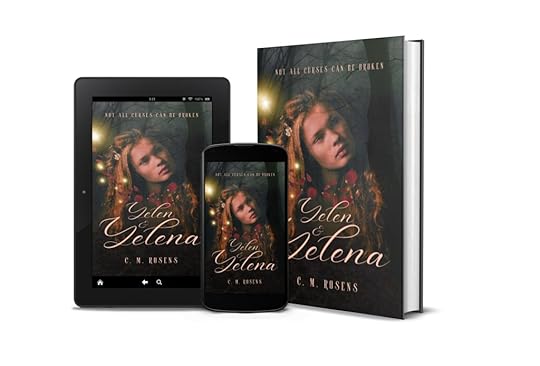 Add To Goodreads
Add To GoodreadsONCE UPON A TIME… In a rural corner of the Provinces simmering with civil unrest, Laundress Yelena’s village is plagued by a dangerous fungal rot oozing from the forest. When she is falsely accused of dark sorcery and evicted from her cottage so her landlord can sell up, Yelena is forced to leave her home and loved ones behind, and entrusts herself to the wind-borne voices of the restless dead to see where they lead her.
Yelen is a forgotten tyrant, turned into a monster hundreds of years ago after accepting a cursed flower, and left to stalk his enchanted castle all alone. Despite becoming a better person over the centuries, Yelen’s aromanticism means he can never fulfil the ‘mutual romantic love’ condition of the curse, and to his relief, he will never have to return to form of the power-hungry brute he once was… But he craves companionship and an end to his lonely existence.
When the wind leads Yelena to Yelen, she discovers a kindred spirit in the aromantic, bi-attracted monster, and their relationship quickly escalates. But being a guest in a cursed castle with a lonely, amorous Beast is not all fun and games – while exploring, Yelena makes a disturbing discovery about the source of the rot, and starts showing symptoms of infection herself.
Can Yelen and Yelena work together to find a lasting cure for the rot seeping beyond the castle walls, or will the curse claim another victim?
Yelen & Yelena Instrumental Playlist – OfficialContent NotesThis is not a romance – the characters are explicitly aromantic (they do not experience romantic attraction, in their cases, not ever) and bi-attracted allosexual (they do experience sexual attraction, and are both bisexual). There are both fade-to-blur and moderately graphic on-page sapphic sex scenes and M/F monster sex scenes. The world is queer-normative and includes non-binary identities.
This book deals with themes of death (loss, grief, murder, suicide, self-sacrifice, and the afterlife), community (its construction, reconstruction, and destruction), family (loss of family, found family, chosen family), possession, loss of agency and autonomy, and mental health issues. There is also civil unrest, lynching of landlords, and the appearance of soldiers and militia.
Content Warnings
Family deaths; frequent suicide ideation; on-page violent suicide and murder; implied SA mention; depression; depersonalisation and derealisation; social ostracism; eviction; some body horror related to the rot (fungal infections, fruiting bodies, etc).
Civil unrest – revolution and civil war, lynching of landlords, soldiers clearing villages and hunting peasants.
Animal death: wolf hunting mentioned, and rabbit hunting and butchery for food on page.
Want it?There are 40 e-ARC copies to claim on BookFunnel. Please note that this is a proof version, so there are still some formatting and other minor editing issues to fix.
In exchange for the free e-ARC copy, please leave an honest review on Goodreads, Storygraph, and especially on the eBook platforms where it will be available to buy.
Go To BookFunnelAre you a Ko-Fi Member?
Ko-Fi Members get their own e-ARC copies on Ko-Fi, one per member. The direct link is here:
Ko-Fi Members OnlyEldritch Family members also get automatic approval for print ARCs. If you want your print ARC, please get in touch and let me know.
December 20, 2024
New Website Launch! Visit Pagham-on-Sea
As an exciting Advent extra, I’ve been gifted the domain name www.visitpaghamonsea.co.uk for Christmas, and I’ve been an absolute menace with it.
(I’ve also made a load of posts and downloads free for you through Advent, and these will stay open to the public until 31st Dec. Check out my pinned post on Ko-Fi for all these links!)
I’ve set up a little website for the town, and enabled comments so that people can share their experiences. There have been some absolutely wonderful responses to this, some of which I’ve posted on behalf of others who sent me their reviews on WhatsApp (cheers friends), and others where people have then commented additional stuff. The town lore is expanding before my eyes, and I absolutely love it.
I will be uploading the town map by Dewi Hargreaves and maybe link to the YouTube video of my birthday spent in the brisk January sea air showing you where Pagham-on-Sea is not (clue in the featured image for this post…). That’s coming soon.
Explore Events – these are canon, or appear in the monthly Ko-Fi letters, or are newly invented for the website. If you want to play along, you can comment on the posts, or offer suggestions for events you’d like to see.
Looking forward to another wonderful flower show! Hoping all entrants are going to be just as ENTHUSIASTIC as previous years!
Explore History – all of this is canon and some aspects refer (and link to) the books! I don’t have comments enabled on this page, but you can comment on this post below, or comment on Things To Do page, if you want me to flesh the History page out more.
Pagham-on-Sea has a colourful town history that includes the burning of 5 Protestant martyrs in 1556, wreckers, smugglers, and duels. Much of this can be explored in the Museum & Containment Facility.
Explore Things To Do – I have 6 featured things at the moment, but I can add more! These featured things link to older blog posts, Ko-Fi posts, and podcast episodes. The comments here are already absolutely unhinged and you can reply to them, and add your own.
Went to what appeared to be a lovely antiques store. Currently on my 50th consecutive day on the run pursued by a demonic doll wielding a meat cleaver. Check provenance on all purchases. 2 stars. (The porcelain is excellent quality)
Explore Where To Eat – I have a page dedicated to where to eat and drink, split into the following sections: Cafés, Takeaways, Pubs & Bars, and Restaurants. You can comment on these with reviews and tips. I’ve linked past blog posts to some of these pages too, especially in relation to the undead community stuff.
Fish shop review. 1 star. How many hands should a fish have? None. NONE. And I’m certainly not paying extra.
Have fun and review responsibly… or… something…
Merry Christmas/Happy Holidays!
December 18, 2024
Author Spotlight: Eric Still
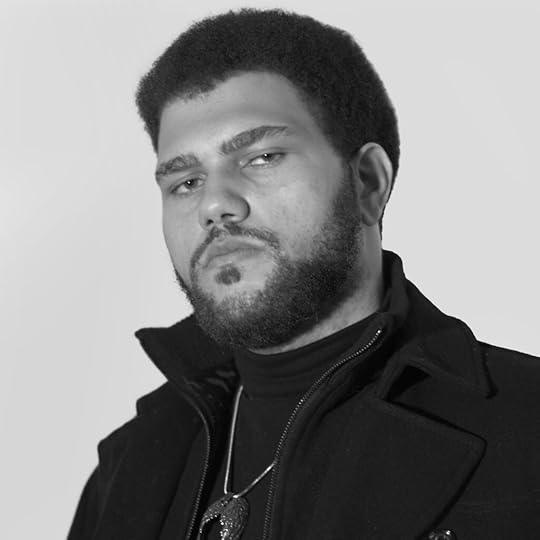
Eric Still (he/him) is a dark fantasy author from Los Angeles California. If he’s not writing, he’s gaming, reading, or cuddling his cat, Grim. Loves horror, cooking, and showing love and support to his loved ones!
Author Links
Website: www.ericstill.com
Instagram and Threads: @eric_authority
Linktree: linktr.ee/eric_authority
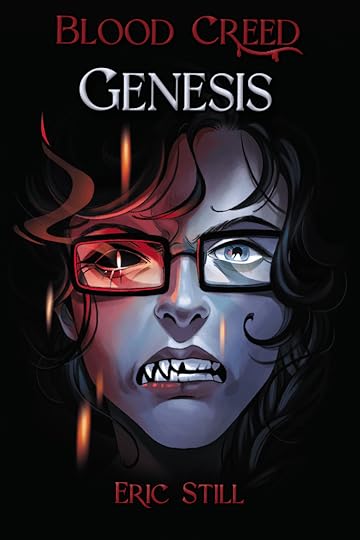
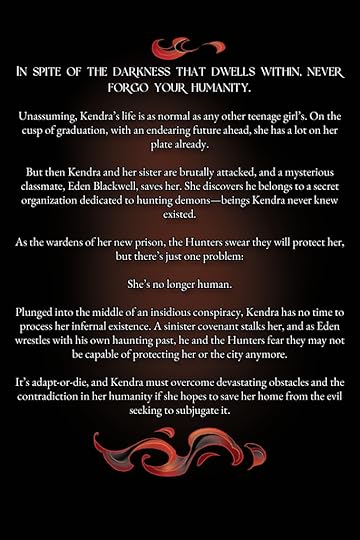
Tell us a little about your series “Blood Creed”, and your latest release, Genesis. What inspired this story and did you always plan this to be a series?
There are a lot of things that inspired the series as a whole, but the biggest ones would have to be the mythological adaptations in Percy Jackson and the dark and nefarious premise of Marvel’s Blade.
I always intended for Blood Creed to be a series, given the character arcs and sheer extent of the lore require more pages than one book would permit.
Genesis and the Blood Creed series deals a lot with philosophies around existence and the nature of sin – what philosophies did you include in the story, and how do these questions play out in the book(s)?
I love this question! So, the beginning of chapter 1 starts with a brief narrativization alluding to the primary theme of sin as a whole as it pertains to humanity. However, the series as a whole is really going to dig into it all.
Genesis, specifically, challenges the nature of being, and where the root of sin and virtue reside. There is an immediate presumption that demons are sinful, and there are seeds that challenge this and presents sin more holistically and with a forlorn consideration as to if it ought to be demonized, pun very much intended!
While planning the series, have any characters surprised you in terms of their arcs and development, or has everything so far gone according to plan?
So, I primarily outline, but in “sticking to the plan,” I adapt and come upon really amazing ideas and discoveries.
It is in viewing something more complete that I find myself able to bolster it the most, and especially in Genesis, I ended up building a character up and granting a paradoxical sympathy to in order to really have the teeth of their situation pierce deeper into the reader.
Less of a one-and-done and more of a challenge to the conception of the aforementioned topic of sin and the nature of a being.
What drew you to New Adult for this series – did you consider YA at any point, or ageing up further to Adult, or did you always feel NA was the right range, and why?
I considered this topic upon finishing the book, namely my beta readers and editors. It isn’t really clear cut, but given this is the Genesis of the series and the main characters are either adults or turning to adults, I the argument for it being YA was significantly weaker considering the dark themes of the book, and the series gets darker and bloodier, so New Adult is more appropriate to me at least.
What other primary themes run through your work that appear in Genesis, and what informs your writing on these themes?
This book is chock-full of several references and themes, but the primary themes I should mention would be the complex nature of what spurs “evil” and how considerations toward that evolve and spur growth in others.
I wrote the book in omniscient, and given lore details I won’t spoil here, I am going to judiciously use that to flesh out characters sooner forgotten as to subvert pervasive formulas while granting them their due respect.
I will guarantee that if you come to enjoy the villains I write, they WILL be done justice under this premise I am abiding by. Gotta develop our villains just like we do our protagonists, I say!
What are you most looking forward to writing in the future books in the Blood Creed series?
I am sure every author hyperfixates and fantasizes about that “one” scene that inspired their story, and I am pridefully included in that cliche. I have SEVERAL I have had in my head for over a decade, which was when I first started making lore, but … Book two is going to be the “heaviest” book in the series, and a particular chapter I am going to write is one that I am most anxious to do right for several reasons.
I love darkness as much as the next edgelord, but I am tasteful and don’t wish to romanticize elements of trauma, merely to encapsulate and immerse my readers in it. If anybody ever reads this interview after reading book two, when I publish it, they will know the chapter/scene I am referring to.
Another mention would have to be what I have in mind for book 4, and the allegorical significance that book will bring with it. Either way, I am super excited to bring this series to life!
Like This? Try These!December 11, 2024
Author Spotlight: Avery Carter
Avery Carter (they/them) cannot remember a time where they didn’t want to create stories. They kept wondering what to do with their life, and finally settled on not settling. They are an English teacher and walking art museum, covered in tattoos, ocean blue hair tied out of their face, and square, purple glasses. They proudly proclaim that they are the “coolest person you know” to their students, and spend each day trying to live up to that title. They are a nonbinary queer author living in South Korea with their wife and two dogs. They spend their days writing new stories, and teaching their students to love words as much as they do.
Author Links:
Website: avery-carter.com
Instagram: @my_graceless_heart
Threads: @my_graceless_heart
What drew you to cozy fantasy as a subgenre in particular, and what made you write your novel Spellbound as older YA, and Honorbound set 5 years later?
A lot of my early reading experiences were informed by Tamora Pierce books and the warm, fuzzy feelings I got from reading her books. My first trilogy, the Moon Trilogy, is a lot darker than what I currently write, and I made the pivot when I wrote The Ghost and the Real Girl. Since then, I’ve enjoyed digging into the genre and exploring all of its little niches.
Spellbound and Honorbound are actually both YA! Honorbound is set five years later, but it has a new protagonist and cast, and a new setting. The characters we met in Spellbound are still hard at work, and they do appear in Honorbound, but both novels can be read as a stand-alone. Writing them as YA is a bit of a challenge, since I’m pretty removed from my teen years, but I enjoy the trainwreck aspects of it. Specifically, it’s fun having characters who know when something is messed up, but they don’t have enough knowledge to fix it. It’s a fun bit of drama.
What is your favourite thing about your protagonist in Spellbound, and what did you most enjoy developing about her in Honorbound?
Emily (the protagonist of Spellbound) is very much like myself. I put a lot of my own experiences into writing her. This carries into Honorbound as well. Without spoiling too much, we get the continuation of a loving relationship, the magical equivalent of screaming through a video call, and lots of researching.
Why a fishy sidekick, and is Orpheus making a return in the sequel?
Orpheus is based on a real-life betta fish I had at the time. I enjoyed the concept of Heroes having a Companion that matched their personality, and Emily’s was a betta fish. It was a good way to show that she isn’t like your typical Hero. Sadly, he doesn’t make an appearance in Honorbound, though we do get a few new Companions to love.
Can you tell us more about your worldbuilding; what sort of research did you do for your magical library setting, and can you tell us a little bit about your worldbuilding process in general?
For The Stacks, going in, I knew that I wanted there to be five levels, and that each level would tell stories in a different way. After that, it was just a matter of figuring out which Level had which trait.
My worldbuilding process usually starts with making a map. I love using Inkarnate to put together a map of the world my characters will live in, and then using that map to tease out details of the magic and the world itself. I tend to look at two things: Food, and Money. With those things, I can figure out what kind of landmasses and agriculture that exists, and then the details write themselves from there.
Did you find plotting a sequel a challenge, or did you always conceive Spellbound as part of a series?
Spellbound was supposed to be a standalone, actually. I never had anything extra planned. Then, I had the idea of a girl who has never had anything of her own, not even her own name, and her best friend who left to go become a Hero. Those ideas became Izzy, our antagonist/love interest in Honorbound, and Gwyn, our protagonist.
What is your favourite reader response to your work so far, and why?
Anyone who tells me they feel seen or understood by my characters or my writing. I tend to put a lot of my own experiences in my books, and it’s very validating and nice to see that other people relate to these experiences too.
Also, everyone who told me the end of chapter 16 of Spellbound made them cry. That was a nice response too haha.
December 6, 2024
Daily December Freebies with Ko-Fi & Podcast Links
I’m posting a freebie to read online or download, every day through 01 Dec-24th Dec, and advertising the links on Bluesky via my @cmrosens.com account. Over on @eldritchgirlpod.bsky.social, my podcast’s account, I’m also posting a Podvent calendar. All these episodes are free to listen to and will remain so!
If you follow me on Ko-Fi, check out the pinned post on my page, and that will have the running list of all the freebies you can access!
Advent Calendar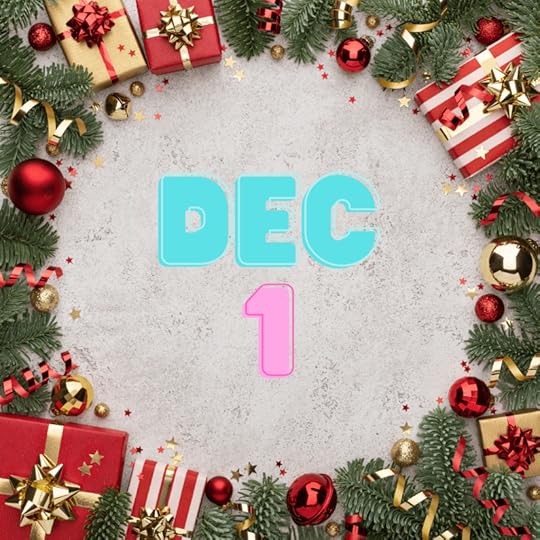
01 Dec 2024: https://ko-fi.com/Post/November-Letter-Carries-Halloween-Update-W7W274EUS – the first letter that members ever received in Nov 2021. It’s from Carrie with a bit of Ricky input.
Podvent Calendar: 01 Dec, go back to the beginning with the first episode of THE CROWS:
https://rss.com/podcasts/eldritch-girl/1291517

02 Dec 2024: https://ko-fi.com/Post/Gerald–Short-Story-for-Hardback-Edition-R5R176HQD – A short Ricky Porter story, “Gerald”. First published in the limited edition hardcover anniversary edition of THE CROWS. This is the genesis of Gerald and how he got his name.
Podvent Calendar: 02 Dec, the audio for the short story:
https://rss.com/podcasts/eldritch-girl/1291415
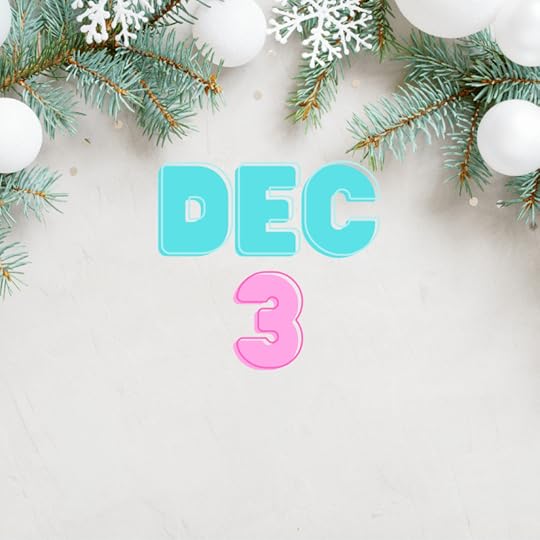
03 Dec 2024: https://ko-fi.com/Post/July-Reward-2024-Family-short-story-L4L610R9PK – What about the family members that got thrown out of the family before the events of the novels, and how did their children cope with their Changes? I explore this in a short story members had in July 2024.
Podvent Calendar: 03 Dec, 3-parter for Day 3 – the complete audio for THE SUSSEX FRETSAW MASSACRE.
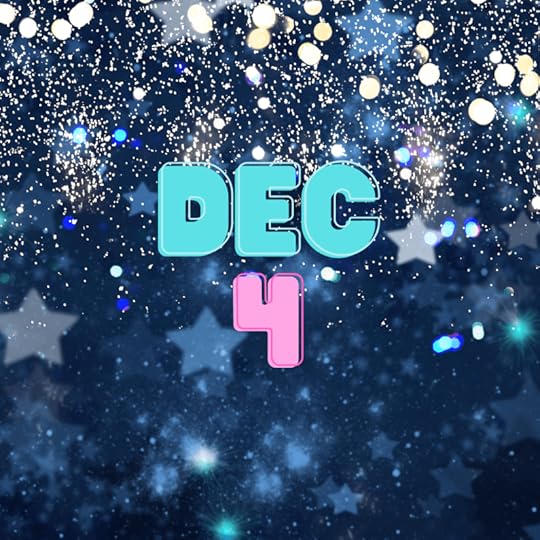
04 Dec 2024: https://ko-fi.com/Post/May-Bonus-Content-J3J1L2FBQ – Have you wondered about how different THIRTEENTH was in the early draft stages? The answer is: extremely. Here is a link to my first 5 chapters when I was playing around with ideas and still getting to know the characters. 28K words of bonus content.
Podvent Calendar: 04 Dec, Paula D. Ashe is starting a developmental edits business, to help you with your manuscript. So I thought I’d boost her interview again! Here it is, as a reminder that you DO want to work with Paula:
https://rss.com/podcasts/eldritch-girl/1291433/
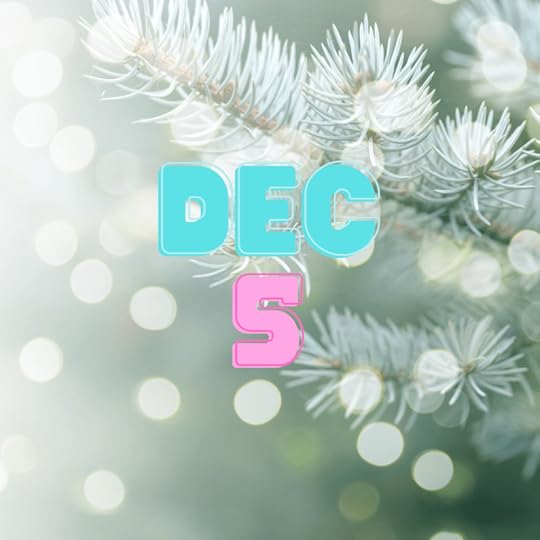
05 Dec 2024: https://ko-fi.com/Post/January-Letter-Katy-Y8Y180IF2 – A short letter that’s part of an ongoing story arc I developed over several months in letters to my members. (New members can download the complete letters 2021-2023 from my shop and catch up on all the arcs they’ve missed, and I’ll be adding 2024 to this once Dec’s letter has gone out!)
Podvent Calendar: 05 Dec, is a reminder of the hour-special interview with Arden Powell. We discussed and compared the settings and themes of their two novellas, THE FAERIE HOUNDS OF YORK and THE BAYOU, the perfect pairing for oppositional aesthetics and dark fae themes.
https://rss.com/podcasts/eldritch-girl/1291421/
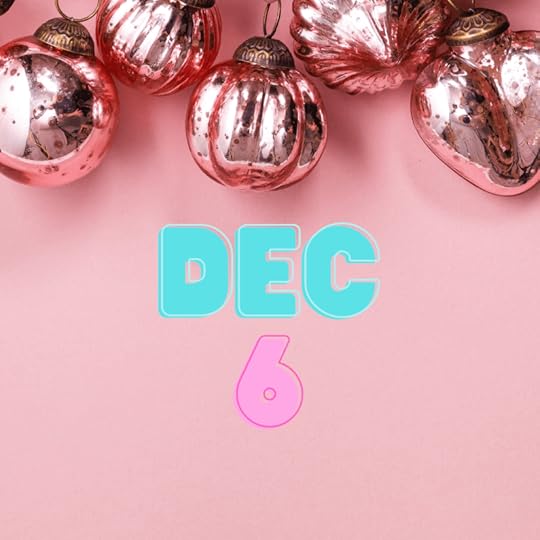
06 Dec 2024: https://ko-fi.com/s/593cfe0d2a – FREE EBOOK DOWNLOAD of my novelette, The Reluctant Husband.
Podvent Calendar: 06 Dec: There’s no audio of TRH yet, but as it is set in 1938, I resurrected this interview with the lovely (but fictional) researcher, Guillaume Velde, where we had a lot of fun discussing the weird history of Pagham-on-Sea as if it was a real place. Faerie lights, wreckers, dramatic duels, and more!
https://rss.com/podcasts/eldritch-girl/1291500/
Watch This SpaceMore freebies coming soon!
December 4, 2024
Author Spotlight: Celeste Harte
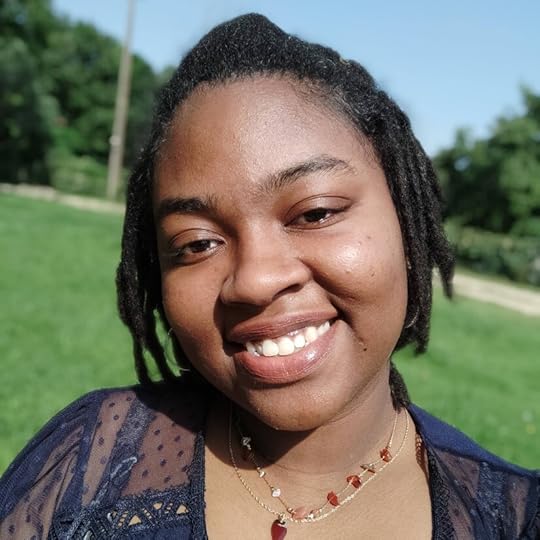
Celeste Harte (she/her) is out here making worlds and taking names.
She writes books, does professional illustrating under her alter ego, Becky Brown, and even makes video games.
Her favorite way to relax is with a good anime or manga, and her favorite games to play range from farming sims to RPG and action games.
Author Links:
Website: celesteharte.com
Instagram: @celeste_harte
Threads: @celeste_harte
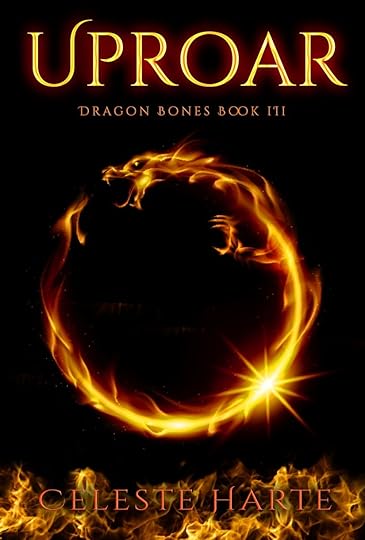
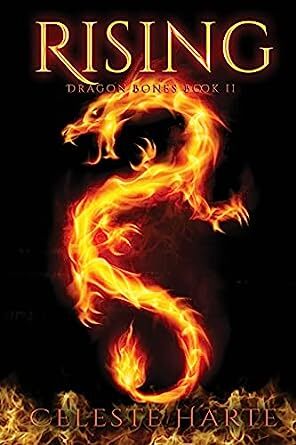
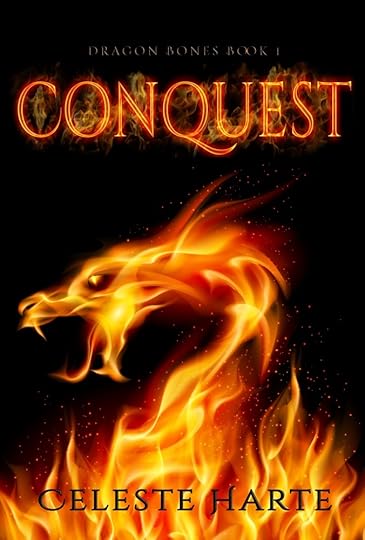 Add To Goodreads
Add To GoodreadsDo you feel that your experiences of living in the US and then in Europe have influenced your writing and the themes you tend to focus on in your work? If so, how?
Absolutely. Having moved various times in my life at a young age, my sense of identity has shifted often. And going through so much change all of the time, I have often felt “other” in most spaces I occupied. My characters can sometimes reflect that feeling in different ways.
In the Dragon Bones trilogy, Jashi has lived in the same place her whole life, but she has a part of her she’s kept from even those closest to her, and that has made her feel isolated. Kahmel has never stayed in one place since becoming an adult, and now he’s used to having to stake claim on a space when he enters it. I think Jashi is more similar to me in that she keeps to herself when she doesn’t feel she belongs. Kahmel is the opposite of her and me. He embodies the boldness I could never have to welcome himself into a space, even if no one has made room for him. I may not go that far, but I do think I wish I had some of Kahmel’s confidence.
When I wrote for the Magic in the Melanin anthology, I do think I embraced more of that bold energy to make a space yours rather than waiting for someone to give you permission. It’s not reflected in the characters I wrote so much as in the approach to writing the story. I created a setting that reflected my interests at the time; I was watching a lot of anime with temples and shrines and I wanted to tell a story inspired by the sort of medium you might see in those animes. The only difference is this is my story, and my characters are all Black.
You have recently completed your Afrofuturist fantasy trilogy Dragon Bones : how does that feel, and can you share some of the highlights of your writing and publishing journey with us?
It feels good to have it finally be over! Interesting fact; the third book almost didn’t happen. I was really stuck for a good while because I got burnt out pretty bad in between rewrites of the first book and editing the second book at the same time (we ended up writing a second edition of the first book, which neither me or my publisher had ever done before!).
By the time I was supposed to write the third book of the trilogy, I had lost most of my motivation to finish. I can’t even articulate why I didn’t want to finish anymore at that point. I think when you work really hard at something and have too much time to think about why, you start wondering why anyone does anything in the first place. At least for me, thinking too long when I’m already not in a great headspace never makes for good decisions.
The thing is, because I was finishing up the trilogy, I wanted to tie up all of the loose ends in a nice and pretty way, so I was doing a lot of research to brush up on story structure, finishing plot arcs and such and so forth. But it wasn’t until I decided to scrap all of it that I really got my groove back.
I got myself in a better headspace and asked myself, what story am I trying to tell? What am I trying to communicate with the ending of this series? What do I want that valiant reader, who has read all of the books and came to the end of this journey with me, to understand about what I’ve told them over the course of three books? When I answered that question, the book flowed, and I actually finished about 60k words in two weeks after that. Writer’s block, soul quest– same thing, I guess.
What, for you, is the most interesting part of writing a fusion of Afro-futurism with both dystopian and high fantasy elements, and what was the starting point for your worldbuilding?
The funniest thing is that Dragon Bones from two concepts. First, I wanted fantasy story with an arranged marriage between two people with powers they didn’t understand until they met each other. That part of the story called to me for a while before I put pen to paper. However, the world that came with it showed up as a “what if” that came to mind after watching Jurassic park. What if the world was full of dragons instead of dinosaurs? What if they were ancient, as old as the world itself, and people just had to… figure out a way to deal with it? After that, my little story with an arranged marriage met the perfect world to encapsulate it.
One of the aspects I was having the most fun with while I was creating the idea was imagining how the world would evolve based upon dealing with the fact that dragons never went extinct like the dinosaurs did. They just had to live with it.
For that reason, I wanted to put my story at a time where humanity has been dealing with dragons for a while. But their solution was inhumane. Afro-futurism came instinctively, really. Anyone that has read the book can see the parallels to colonialism a mile away. It just felt really fun to make colonizers cyborgs and give my Black characters dragons and fire magic to free themselves.
If you can share without spoilers, what is your favourite thing about the characters’ arcs as they progress through the trilogy?
I love watching Jashi evolve with each book. It was an interesting feat, editing Rising while writing the second edition of Conquest. It was like writing two different characters when I wrote Jashi in each of them. That was one aspect that made editing the two books at the same time so jarring. When I finally found the voice of the story in Uproar, I really was amazed by how Jashi evolved again and became the heroine she needed for herself. Jashi’s arc will always be my favorite part of Dragon Bones.
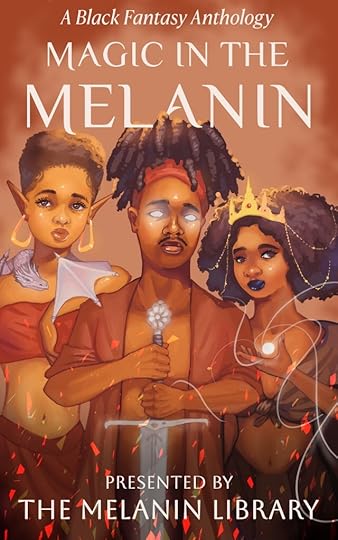 Preorder Now
Preorder NowYou are involved in the release of the Black Fantasy anthology, Magic in the Melanin, which is coming soon (Feb 2025)! Can you tell us how this anthology got started as an idea, and the editorial team behind it?
Magic in the Melanin was conceptualized because we (the editing team) needed two things: to find magical Black books, and create them. Chelsea Lockhart, owner of the Melanin Library, resolved our first need with the Melanin Library, and we fulfill our second need every day as Black authors making stories for ourselves and others like us. But here’s the thing. The Melanin Library is an incredible place to find Black books in every genre by Black authors. But it needs funding to keep itself afloat. Therefore, in order to keep making it easy to find magical Black books, we decided to find even more magical Black authors to contribute to this love letter to all things fantastical and melanated.
With the aim of funding the Melanin Library and keeping this treasure trove available to everyone, the four of us, Chelsea Lockhart, La Purvis, and Tatiana Obey, decided to bring together fantasy stories written by Black authors that would carry none of the heavy trauma that makes some of us turn to fantasy books in the first place.
Magic in the Melanin will feature absolutely NO racial trama between its pages, and that’s one of my favorite things about it. We’re telling stories about what happens when we just talk about being ourselves with no one else in the room. It has been awesome seeing what people came up with when that concept was presented to them.
What are the main themes of the anthology, and can you tell us a bit more about the content and what we can expect?
As I mentioned, there is no racial trauma in Magic in the Melanin. In none of these stories will there be any race of people that we all know represent melanated folk being oppressed by some group of people we all know represent the melanin-challenged.
These stories will be lovely, they will be creepy, they will be sweet, they will be messy, but they will be ours.
Everyone that has worked on this project is Black, and everything within its contents is a love letter to them and others like them. I honestly can’t wait for everyone to feel the love coming from the pages when they get theirs.
Like This? Try These!November 27, 2024
Author Spotlight: S.R. Severn
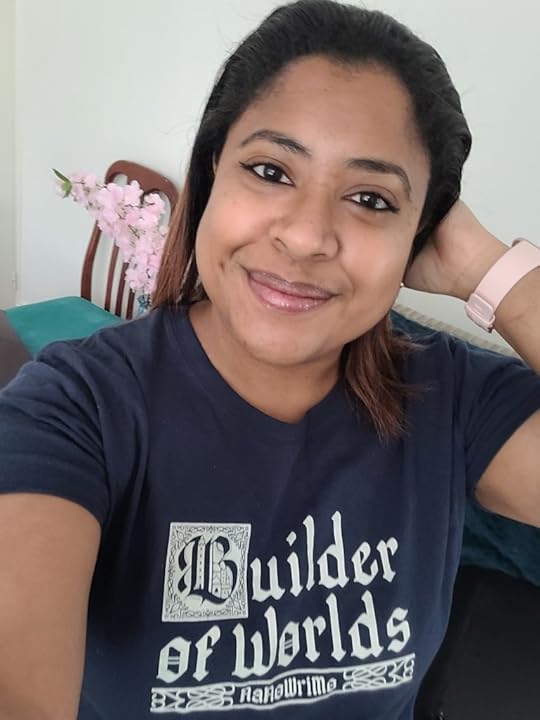
S.R. first became obsessed with romance through reading Mills & Boon at an early age, where she promptly fell in love and sought to devour every romance book in sight. Her writing journey began after university with her Creative Writing degree securely under her belt. She loves mythology and steampunk, even having her own hoard of steampunk trinkets on display in her home in London, UK.
S.R. enjoys creating fantastical worlds where love triumphs under dark and difficult circumstances. It also explains for love for dark romance books. When she isn’t writing, she can be found gaming, binge watching shows or (on a whim) baking.
Author Links:
Instagram: @s.r.severn_author
Website: srsevern.com
GoodReads: goodreads.com/srsevern
Amazon Author Page: amazon.co.uk/dp/B00IK8EJ8I
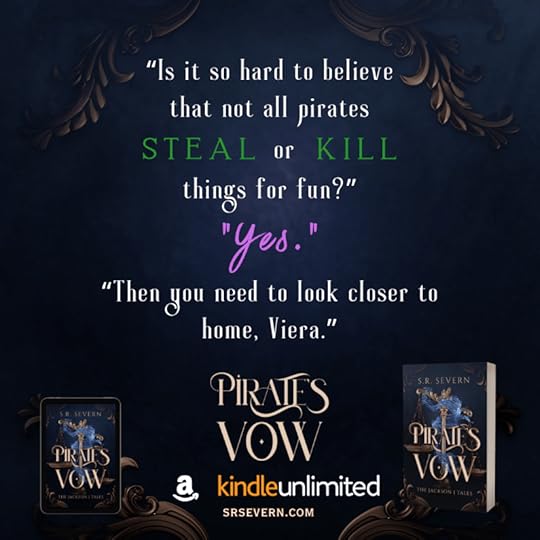
What was the inspiration for Pirate’s Vow and do/how do these influences show up in the novel? Are there any Easter Eggs etc?
I’ve always had a love for mythology, steampunk, pirates and romance. During my university years, while exploring different mediums of writing and having my preferences rejected, the desire to create a story (my own personal project) was born.
Initially it had just been a way for me to express myself and enjoy what I was writing. I had no idea that this little project would undergo years of editing and development to one day be a published series. But I’m deeply in love with it and so glad that I was brave enough to take that leap because I haven’t yet come across a book with these combined elements!
Do you find yourself drawn to certain types of characters, or do your characters surprise you as you draft?
I’m drawn to broken characters. The cherry on top for me would be the characters who begin hopeful and optimistic, then tragedy strikes and they become a shell of their former selves. My reason for this is because I enjoyed mending them, and that’s normally through a long, difficult journey of lessons and reflection…and love (self-love and/or romantic love). My characters do have a way of surprising me. They torment me just as much as I torment them!
What was your favourite part of the worldbuilding process for Pirate’s Vow?
Integrating steampunk elements and creating my own unique spin on the mythology/history of the world I created. Oh and the freedom of being able to create a world I myself would be in awe of and eager to escape to without any restrictions. It’s far from a perfect world though, I needed my characters to be born into a dark and twisted world so that the readers could experience struggles with them and celebrate when they survive against all odds.
What were the most important elements of the romance dynamic for you, and was it hard to get this the way you wanted on page?
My MMC (Kennedy) and MFC (Viera) were never looking for romance, it just sort of ‘happened’ and with it came its obstacles and difficulties.
In the beginning their romance was whimsical, fresh and mistakenly confident. Years later, their love rekindled with safety being the main element. Both strive to protect the other at all costs and seek to provide safety even though it often ends with them fighting for dominance. That’s also where a lot of the humour unfolds between them, Kennedy tends to be sarcastic, using humour as a coping mechanism and a mask.
Viera is often too serious, but I guess it’s the price of being a police officer. The difficulty I encounter with two characters locked in a power struggle is figuring out who will compromise or win. I used to be a hardcore plotter, knowing how events will pan out, however that’s drastically changed. I still have an idea of where my characters will end up, though I have no idea what happens on the journey until I’m writing!
Can you talk a little bit about your ideas around love and social justice, and how these two themes intertwine in your novel?
I remember when I first began world building, I had a desire to create a world heavy on a hierarchy of status. Kennedy and Viera appeared to me as two individuals who were at the bottom of the food chain as slaves. Kennedy has always been a dreamer, having been raised with the truth that his parents were born free, he made it his destiny to fight for the freedom of his whole family.
Whereas Viera, whose father had given up his Highborn status to be with the slave he loved, has lived her life accepting her freedom as unattainable. It’s only after Viera falls for Ken does she begin to consider freedom with him. Even years later, despite them being free from slavery, they’re still slaves to their fear and trauma.
What they thought was freedom ends up being just another chain they have to break. It’s love and understanding that will help Ken and Viera liberate themselves in a world so quick to condemn, judge and imprison.
What is your favourite reader response to the novel so far, and why?
I’ve had more than one reader comment on the great world building which makes me really proud. Admittedly, I was worried the world would be confusing to imagine or understand, so I feel so accomplished knowing my readers can easily submerge themselves into the story and enjoy the uniqueness of the world.
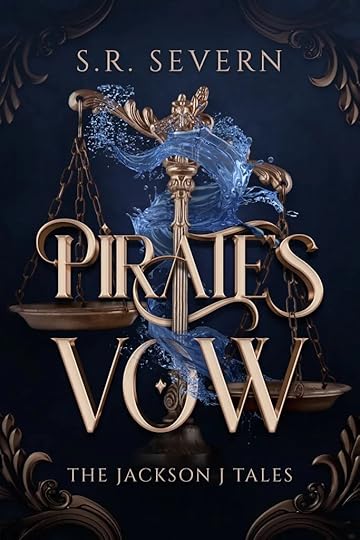 Buy NowLike This? Try These!
Buy NowLike This? Try These!
November 20, 2024
Author Spotlight: Avrah Baren
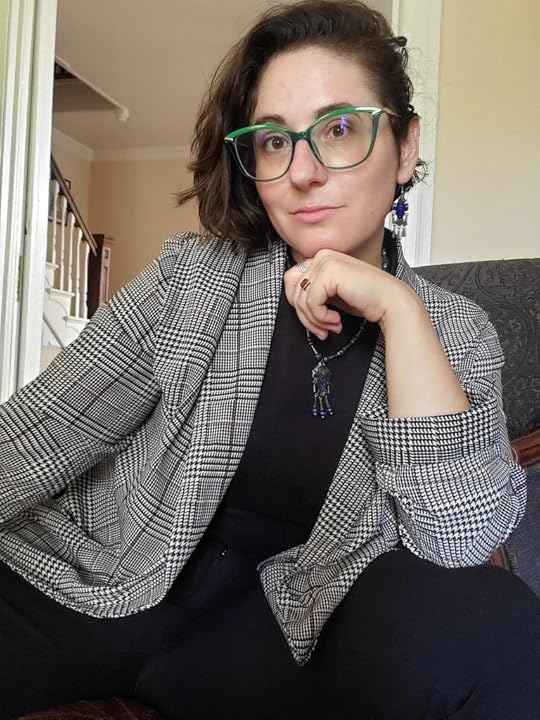
Avrah C. Baren (she/they) is a fantasy writer based in the DMV [D.C., Maryland, Virginia area], where she lives with a neurotic tuxedo cat. She is an alum of the Pitch Wars Class of 2021 and a graduate of the Futurescapes 2023 Writers’ Workshop. They spend their days researching mangroves and landcover change, which is probably why she mostly writes worlds with huge forests. They love writing fantastical tales with Jewish-coded and explicitly Jewish characters that explore our connections with nature and each other. When she isn’t writing, she is climbing rocks, working at the Renaissance Festival, and trying to become a wood witch.
Website: abigailiswriting.com
Threads: @avrahwrites
Instagram: @avrahwrites
Substack: @avrahwrites
TikTok: @avrahwrites
First Comes Death Amazon: https://tr.ee/WCYmU7IP9q
Of Stardust Amazon: https://tr.ee/IfaosyB7Xb
Of Stardust B&N: https://tr.ee/TRaBuDBTdO
Buy from an Indie Store: https://tr.ee/3zCAGC5fDG
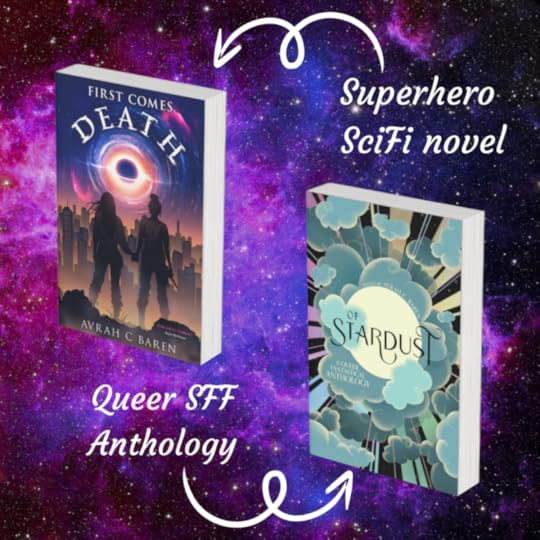
Do you find SFF lends itself particularly well to the themes and character dynamics and development arcs that you like to write, and why?
What I love about SFF is that you can be as tied to reality as you like. Or not at all. It means you get to add layers of complexity to the themes you’re exploring or the arcs your characters experience. In particular, I love writing about characters coming into their own strength, whether it’s mastering a superpower or making peace with a curse in a way that has them coming out stronger. When you write stories in the speculative arena, there are so many ways to play with this dynamic. For example, Ivy and Dina, the main characters in FCD both get vastly different powers and vastly different abilities to use those powers. Ivy has control of her powers right away. For Dina, it’s much harder. Both of them learn so much over the course of the novel that makes them stronger, but because there’s a speculative element to their strength, there’s a layer of complexity I really enjoy. While there are ways to explore growth and strength in the contemporary world, the ability to play with fantastical elements allows you to ask so many different questions.
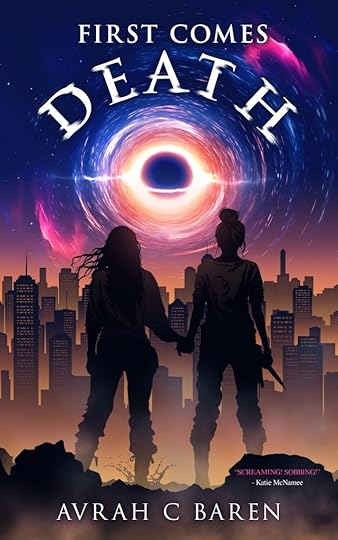
In your novel, First Comes Death, you explore the idea of people gaining certain abilities/powers after resurrection – what made you want to explore ‘superpowers’ for want of a better word, through this darker lens?
Like so many people, I have always been fascinated by the idea of having superpowers. I grew up watching Xmen and have always imagined what it would be like to live in a world like that. Xmen plays with the idea of superpowers presenting after an especially stressful life event. I wondered what would happen if you took it a step further. If you were “reborn” into your powers. How would you live your life differently with the combination of receiving a second change AND superpowers. And what if that second chance came with strings? I often go to dark places in my own head, even when playing with the idea of superpowers. Tying those dark elements into the story was a way for me to face them in a way.
Does the queerness of your novel interact and speak to the themes of transformation and change, and do you think there is something unique about queer stories over cishet ones – as in, some layers that queer stories are uniquely placed to explore and develop, e.g.?
While the queerness in First Comes Death is somewhat normalized (most of the cast is queer), characters still struggle with how they interact with the world at large. I particularly think of Dina when I think about this question. She is on the verge of coming out when she dies and resurrects with uncontrollable powers. While other characters are fairly comfortable in their queerness, she starts the novel still in the closet. Many queer folks are not safe to or don’t get the chance to come out.
What I love about Dina’s arc is how she transforms and changes despite missing out on this moment and that she comes to accept herself fully even without officially “coming out”. Not only does she change by coming back with superpowers, but she also experiences this internal change of becoming comfortable in her own skin.
Queer stories about change and transformation are absolutely unique compared to cishet stories. I came out late compared to many people I know, and over the years it’s come with so much more self-doubt than I ever expected. And yet, I have also transformed more than I ever could have imagined, both in my aesthetic and how I view the world.
I think that queer people growing up in a heteronormative society must inherently experience this transformation. From imagining the world the way society tells us it is to seeing it for all its infinite possibilities, we have to do so much introspection that cishet people never have to do in order to understand our own queerness and rewire our brains and unlearn what society has told us about who we can be. And for those of us who have managed to do that, we are absolutely transformed. And I for one feel so much freer from having gone through that transformation.
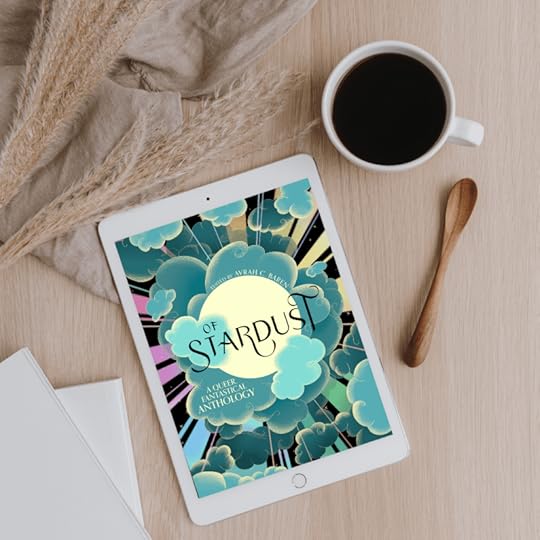
Can you tell us more about your short story in the Of Stardust anthology – what is it about, and do you explore similar themes to your novel, or something different?
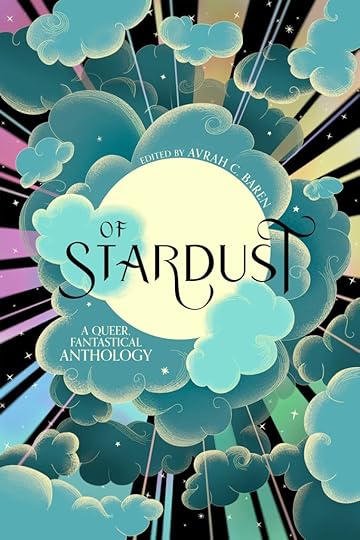
My short story, Unbury Yourself, is one of my favorite pieces. It’s about a creature from Jewish folklore called a Yeduah. A Yeduah is essentially a sentient plant being that is connected to the earth via a vine-like umbilical chord. In this story, a stranger arrives in the Yeduah’s forest and opens it to a world of possibility. It is still queer, but explores very different themes than First Comes Death.
I love digging into Jewish folklore because it helps me connect with my own heritage, as well as a piece of Judaism that was almost buried by centuries of forced assimilation. Not only does this story feature a small part of that folklore, but it also examines the impact of false promises and how seeing one small part of our big, beautiful world can leave you aching for more.
What are your favourite tropes and character dynamics to explore in your work, and why?
I am an absolute sucker for “I’ll find you anywhere” and WOW do I put that to the test with these globetrotting characters! I’m an emo kid at heart so yearning is something I absolutely love to have in my writing. And what could induce more yearning than two characters separated by strange powers trying to find each other all over the world?
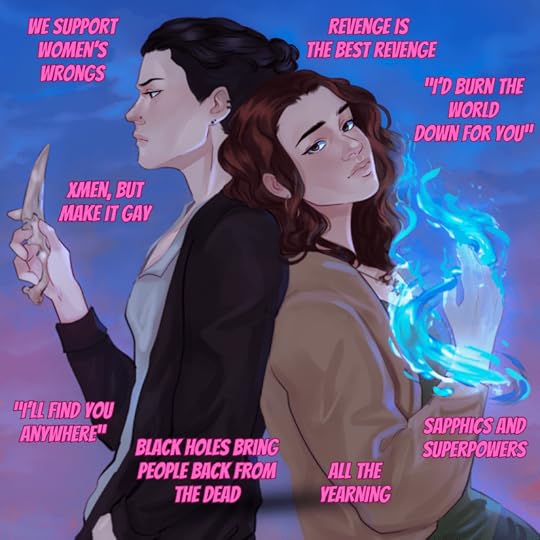 Tropes and Art for Avrah C. Baren’s books
Tropes and Art for Avrah C. Baren’s booksWhat is your favourite reader response to your work so far, and why?
I put a few quotes from beta readers on the cover of First Comes Death, and one of those quotes is “SO SATISFYING AND GAY! AMAZING!” which is an absolute gem.
In general, I’ve also received some wonderful responses to Topher, one of they side characters. They’re just such a loveable nerd who will make sure they ask for your pronouns even in life-or-death situations. I’m so thrilled readers love them as much as I do!
Like This? Try These:November 13, 2024
Author Spotlight: Stuart Tudor
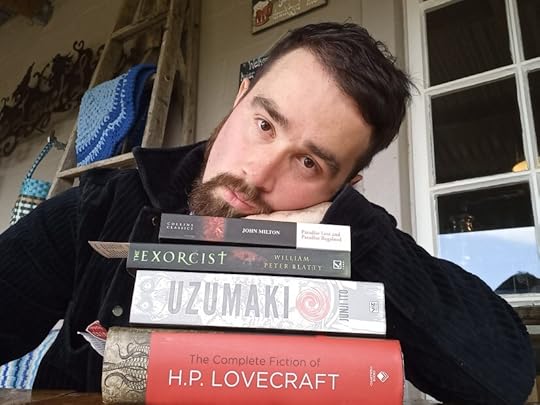
Stuart Tudor (he/him) has been devouring stories since he was little, a habit cultivated by countless bedtime tales. It was during his high school days in 2015 when, after reading The Strange Case of Dr Jekyll and Mr Hyde and playing Fromsoft’s Bloodborne, he began to appreciate horror.
He has always been creating his own stories, reflecting his fascination with the imaginary. This motivation to write would quickly lead him to explore dark themes and settings. His love of writing and horror would produce the Eight Nightmares Collection: A collection of stories about the dreamlike, the surreal, and encounters with the fantastical. An entrepreneur at heart, he has embraced the self-publishing route- delivering horrifying tales that will scare and thrill people the world over.
When away from the word doc, Stuart is studying for his degree in English or working in managing properties and real estate. If he is not doing that, he is taking a breather with a good book like Berserk, playing Baldur’s Gate 3 or watching the latest Scream movie.
All Author Links: https://linktr.ee/stuarttudor
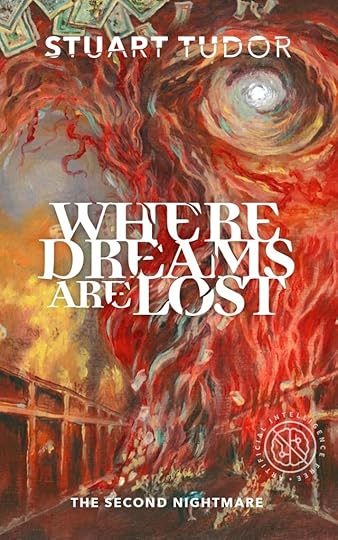
Tell us about the setting for your book, Where Dreams Are Lost; was this story always set in 2008 Detroit when it came to you as an idea, or did you play with other ideas first before settling on this location?
Not really, although when I was writing it, I did consider changing it to the 1920s. But I decided to move that setting to Black Masquerade, which suited the themes and tone better. 2008 was a blessing and a curse to the story because people complained that the themes were too relatable, too close to what had happened in the past, and what was happening during production with Covid.
As of now, Where Dreams Are Lost is the most difficult to market cause of all the terrible memories it can trigger in the reader. Reading about the closure of the Owings Mills Mall as showcased in the Contrapoints video Opulence inspired me to write Where Dreams Are Lost. It saddened me to see all that prosperity go, the optimism vanishing to be left with a hollow shell. I also was influenced by Covid. In South Africa, we have been struggling economically for a while with unemployment. As someone who worked hard to find a day job throughout my 20s before Covid took the little job opportunities I on the table, I felt it. My family protected me and my brother from the worst of 2008, making it somewhat palatable to me to write something set in that era rather than Covid. Detroit was a prime target for me. Rather stereotypical, I know, to select Detroit as the symbol for the dead American dream, but it has been well deserved. Detroit has struggled with urban decay and loss of prosperity ever since the 1970s, I believe. It was also the first US city to declare bankruptcy in 2008. Detroit in this instance was at the forefront of the great recession, one of the worst hit. It would make sense to have Where Dreams Are Lost set in that time, in that location.
What atmosphere were you hoping to capture in the book, and what writing techniques did you use to create it?
Silent Hill influenced me a lot when making this story, chiefly SH2 PT and SH3. I hoped to capture that surreal, nightmarish atmosphere through the imagery and themes. I wanted to imagine how the town would behave if some poor sap got lost during that terrible year. Now, a video game is very different from a book.
The lack of a visual medium can make it difficult to translate the feeling of Silent Hill into a nonvisual medium. I tried to use lighting, sound and personification to drive home the hostile environment, the fact that the monsters have a personal connection to our heroes was also important. It was my responsibility to make sure that the audience grasped (without spoon-feeding them) the fear James and his pals encountered in the mall and how it impacted them. There was a lot of fun, so many monsters, so many were cut from the final release.
There was also the aspect of the mall itself I wanted to use to help convey the atmosphere. I wanted the reader to feel like they weren’t sure if the mall was alive or just mimicking life. Much like Silent Hill, the Grand House Mall had to have a mind of its own, but how much is up for debate?
It thrills me to keep my readers on their toes; I want them to think as they read; I want them to wonder about the story they have read. I think a quote from PT sums up the sort of atmosphere I wanted to create for Where Dreams Are Lost: I walked. I could do nothing but walk. And then, I saw myself walking in front of myself. But it wasn’t really me. Watch out. The gap in the door… it’s a separate reality. The only me is me. Are you sure the only you, is you?
How did you build the characters of James, Harvey, Latisha and Alice in the novel, and did they develop organically through the drafting process or did you have them planned out before you began writing?
Originally, in the first draft, it was just James, Harvey and Alice. They didn’t change much as the drafts continued, but they were all rather sad down on their luck people who get trapped in their own hells. Some complaints of that draft were because of the lack of hope in the story. Everyone lived miserably and died as such. So, I invented Latisha following the advice of a friend to include someone who isn’t destitute. That was what the story needed, someone who could help her friends through their troubles and her own. She becomes the mama bear in a sense to the group after the mall starts messing with them, protecting all of them as best as she could.
In the first draft, James and Harvey had feelings towards each other but ultimately don’t express it and they all die. That also had to change, to make the story a bit more hopeful. They do express themselves and hopefully get together (at least I hope so). There were a few monsters that got cut from the first draft that would reference the character’s struggles, such as starvation and prostitution, among others. These were too dark and cruel for me to include, so I reduced the number of things potentially suffered by my heroes.
Do you find yourself returning to specific themes in your work? If so, which ones?
When I wrote Where Dreams Are Lost, I was still working out what sort of writer I want to be. I would say that this story, along with in part Black Masquerade, helped me understand a core theme of my stories: survival. I am a noble dark writer; having studied some of the darkest moments in human history; I live in a country that is often violent and filled with struggles from all walks of life. All my characters encounter and endure hardship (mental or physical) but they fight through it. They want to fight; they have something to look forward to. I think this is an important aspect of the human condition, the need for hope and the desire to find the good times. There are other themes, of course, such as mental health, friendship, family, the march of progress among some others. Those who follow Eight Nightmares will notice how certain stories rhyme thematically to others with the collection. Crimson Dolphin is a bit of a mixed bag of themes, except for survival.
What is the scariest thing that has happened to you in real life?
I think that might have been when some baboons broke into our car at Cape Point, one of us left the window open and they got in and did their thing. Pretty scary, as baboons can be rather violent if you try to get in the way of their food.
Tell us about your other work: what should we be looking out for, and where/when can we find it?
The ongoing project, Eight Nightmares, has already released three of the eight, with the fourth, Our Broken World, hopefully releasing this year. The rest (A Farewell to Humanity, The Fang and the Claw, Divide the Zero and Praise the Morningstar) will be released as I complete them. Once completed, there will be a single volume for Eight Nightmares called The Eight Nightmares Collection.
Additionally, I have Crimson Dolphin, a collection that will be released in its entirety once it is completed. About half of the stories have their final edit pending, there are eight total. I am also part of an anthology coming out on October 30th called Macabre Multiverse. My contribution will be Fast Radio Bursts, an apocalyptic short with cosmic horror elements.
You will find Eight Nightmares, Crimson Dolphin and Macabre Multiverse basically everywhere. But Macabre Multiverse will be the first time a story of mine will be in a physical book. That is cool as hell. You can keep updated on every project’s progress weekly on my Patreon or monthly on my newsletter.
Like This? Try These:


